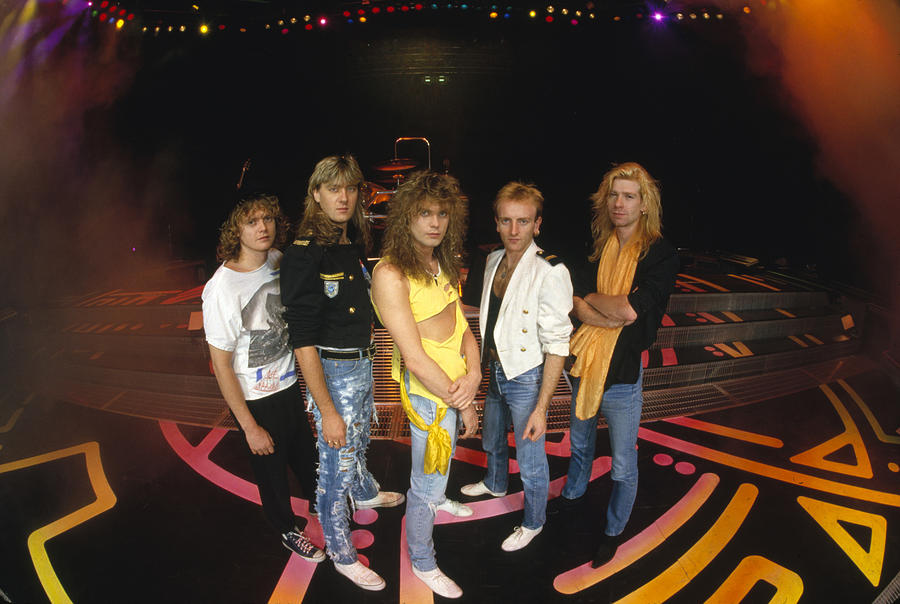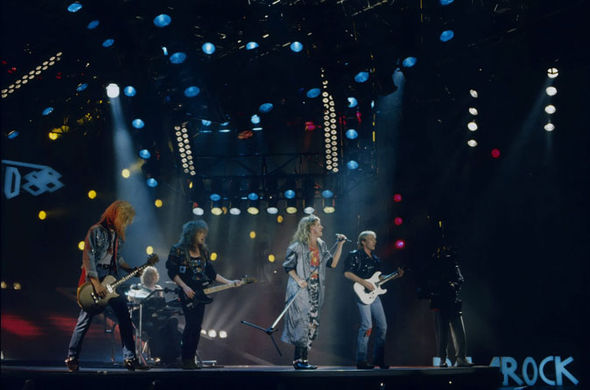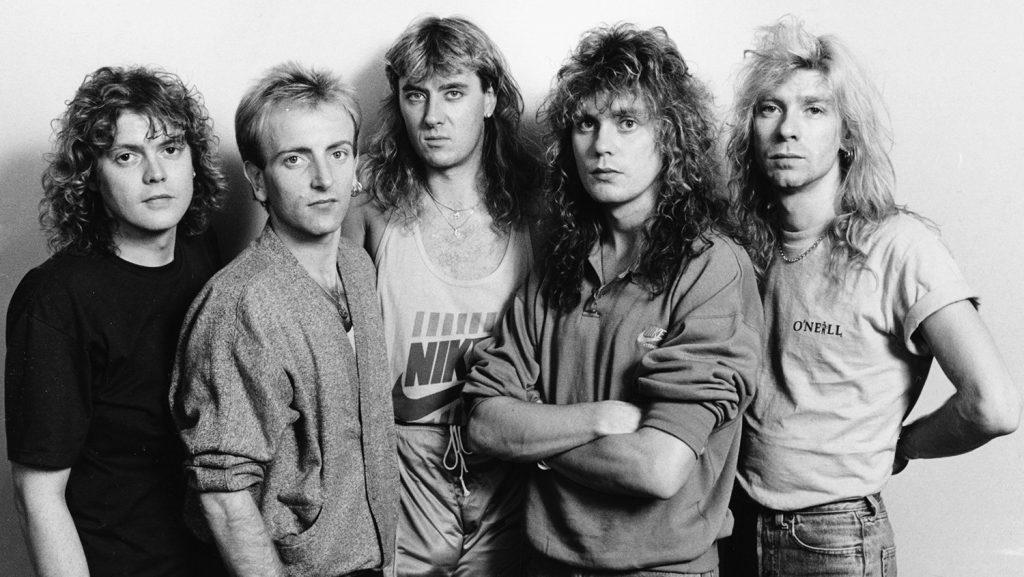Turn up HYSTERIA on Spotify to catch the new Storylines and learn more about the making of the album HERE
Tag: hysteria album
Hysteria Commentary from Band Members
Check out what the Def Leppard members had to say about the making of Hysteria and its international success, years after the album’s release!
Released 3 years ago for the album’s 30th anniversary, the “Step Inside: Hysteria at 30” documentary gives fans an inside look at the making of Hysteria, 30 years after its release.
Phil revisits the making of HYSTERIA
Joe’s commentary on the success of HYSTERIA
To check out more videos, head to the Def Leppard YouTube Channel HERE
Enter To Win A Signed Hysteria LP & More!
It’s that time again! We’re celebrating the end of the tour with your fan photos, but this time we’re putting them on our Instagram ✅ plus, one lucky fan will win a SIGNED Hysteria 30th Anniversary LP & a Def Leppard t-shirt & mug! Enter below.
The Hysteria Files with Phil Collen
Don’t miss our exciting new YouTube series – The Hysteria Files With Phil Collen – as he takes a trip down memory lane and revisits the Hysteria album 30 years later.
Never Before Seen Hysteria Photos + Full Nigel Green Interview
Recording Engineer Nigel Green discusses the groundbreaking, innovative wizardry devised in the studio long before the existence of Pro Tools, and gives Def Leppard fans an inside look with never-before-seen photos from the Hysteria recordings.
Click here to read part of this interview and more from the band members on Billboard.com
I think to summarize the recording of Hysteria I’d say we tried to do what people do now when they record in Pro Tools, but back in 1985 Pro Tools didn’t exist.
In the UK, during the 80’s, record production was getting more and more sophisticated. Most of the time we recorded each instrument separately, a big departure from what was going on in the late 70’s where bands tended to record live together. I think the reason was that in the 80’s it was all about making music production larger than life. Like Spielberg with the movies, everything was edited to the nth degree. You had to blow people’s minds.
But that creates its own set of problems. Recording instruments separately requires re-creating the original feel of the music. This is something that naturally happens when any band plays together but when you record one instrument at a time the feel is very hard to replicate and it takes time. We would punch in and out of the multi- track tape recorder. (‘Punch’ was a term used in the old days meaning to replace parts of the recorded music in an ef ort to improve upon the original performance). Sometimes we’d replace whole sections of songs, other times just bars or even a single beat. We’d do this over and over until we got the feel just right.
Of course this meant that instead of an album production taking a month or so, it could take anything up to a year. Of course with Hysteria we completely annihilated that barrier… it took three years!
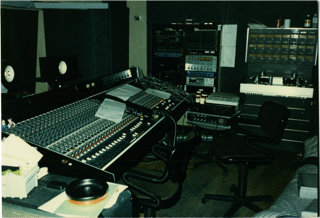 “Control Room in Windmill Lane”
“Control Room in Windmill Lane”
To be fair though, during the first year of recording the band used a different producer, Jim Steinman. After 8 months they parted ways and I was brought in for what I thought would just be finishing off recording vocals and final mixing. But it soon became clear that a lot of the record still had to be recorded. I did my best re- recording guitars to beef up the sound and improve certain parts. We plodded on for quite a while but in the final analysis it was really Mutt they needed.
I have to say Steve Clarke was a really funny guy to work with. You had to have a sense of humor working the hours we did or you’d go crazy. We’d be working on part of a song for hours at a stretch and suddenly he’d say, “Well, we’ve got all the notes… now we just need to get them in time and in the right order.” He’d have us rolling around laughing.
Then just after Christmas, 1984, Rick Allen had a terrible car accident and lost his left arm. We were all shell-shocked. The story I heard was Mutt went to Rick’s bedside and convinced the 21 year-old he still had a career playing with the group. His eyes lit up; all he ever wanted to do was play drums. That’s when Mutt decided to get involved, and Hysteria the album really got started. From that point on it was two years in the making.
We recommenced recording in a Dublin studio called Windmill Lane 2. It was a jingle studio with a pretty cheap Soundcraft board. From the get-go we all knew this was going to take a long time so we saw no reason to be locked into a really expensive studio for the lengthy recording process. We’d save that for the mixing.
To explain why Hysteria was recorded the way it was you have to look back to Def Leppard’s previous album, Pyromania. Mutt and the band would write and record the music while in the studio. Mutt is all about the song first, then the performance, then the sound. He wanted freedom in the studio to change parts of songs anytime he thought they could be improved upon musically, and that meant at anytime during the recording process. This led him to decide to leave the drum arrangements until last in the whole recording process. The reason is once you have the drum parts set in stone in a recording it’s very hard to change the arrangement later on. With an analog multi track tape machine pretty much everything you’ve already recorded is set in stone.
Nowadays, changing the arrangement of a song is a lot easier to do using Pro Tools. But we didn’t have Pro Tools back then. (You’re going to be sick of me saying Pro Tools soon)☺️
So on Pyromania they decided to leave the drums to the last and start recording bass and guitars to what was essentially a click track. The click track was there to help them record everything in time before they recorded the final drums. It was a Linn Drum (one of the first computer drums) playing straight time, no cymbals, no toms, just kick, snare and hat.
At the time this was considered a very unorthodox way to record. No one in the music business was recording the drums last. But there was a real method to the madness. It allowed Mutt and the band to explore new ideas freely.
(Very much like everyone does nowadays with Pro Tools.☺️ Aaaagh.)
On the Hysteria album Mutt was changing and adding things even at the final mix stage. On Gods Of War, Phil Nicholas (Mutt’s Fairlight programmer) found all the Thatcher and Reagan sound bites to sample into the Fairlight so we could use them on the final mix.
The intro to Pour Some Sugar On Me was changed even after the album was finished (and pressed!). It was just Phil Nicholas and me messing around with samples on the Fairlight, for an extended version of the song. Mutt came in and heard it and said, “Great, do it.” Without recording the album the way we had, we wouldn’t have been able to make changes like that.
On Hysteria, the drums were always going to be recorded last. But after Rick’s devastating car accident Rick had to design and build a whole new drum kit with electronic triggers, and learn to play drums a different way so that he could be ready to record with his new drum kit before we went into the mixing.
On Pyromania they put the bass down first on all the songs. That’s fine if you record the bass in one take, but, as I said before, they were punching in bars and even beats to make sure they had the right feel. This would often take all day. What they didn’t realize is that the bass would slowly drift out of tune because the air conditioning kept coming on and off, changing the temperature of the room. This would change the tension of the bass strings and therefore the tuning of the bass. So if they weren’t constantly checking the bass with a tuner it could drift out of tune. It’s hard to hear that happening without any other instruments interacting with the bass at the time. The end result was the guitars had to be tuned slightly differently between choruses, verses, and bridges on different songs on Pyromania. It was a nightmare.
So on Hysteria we decided to do all the guitars first before we put the bass down. It’s a lot easier to hear guitars drift out of tune. The problem now was we were recording guitar parts to no drums or bass, just a click track to keep us in time. It was very hard to envision what the dynamics and the final sound was going to be like without bass and drums.
On Pyromania the guitar sounds were recorded using a Marshall 100 watt amp. But they went through a ton of guitar amps (and a whole lot of time) before they found the right one. Eventually I think the amp blew up.
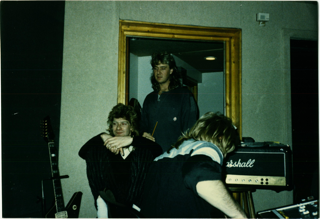 “Before we decided to go amp-less”
“Before we decided to go amp-less”
When Mutt finally arrived on the Hysteria album he didn’t want to go through that again so we decided to go for processed guitar sounds using something called a Rock Box. Other times we would us a Rockman, made by Tom Scholz. The Rock Box had similar settings to the Rockman: a clean sound and a distorted sound. The difference was you could turn off the chorus and effects on the Rock Box allowing you to use your own effects.
So the plan was we were pretty much going to use either the Rockman, or Rock Box for everything guitar wise. If the sound was not right after we added EQ or some outboard gear then we’d maybe change to a different guitar or add some kind of effects pedal. Sometimes I would blend a Roland studio flanger in to beef some of the power chord sounds. We pretty much would try anything to make it work, but in the end if it wasn’t cutting it Mutt and the band would change the guitar part altogether.
A lot of people couldn’t believe we didn’t use real amps. But this is where Mutt taught the band and me that music production is about the song and arrangement first, then performance, followed lastly by the sound. If the song and the arrangement is great, and the performance is great, then the sound quite often takes care of itself.
We were recording the guitar verse jangle for the song, Hysteria. Sav was playing the part and the problem we were having was the Rock Box clean sound was so compressed you could hear every finger fret movement almost louder than the guitar sound itself. We liked the sound of the jangle but there was no way we could allow this scratching fret noise between chord changes to be part of the recorded sound. So what to do?
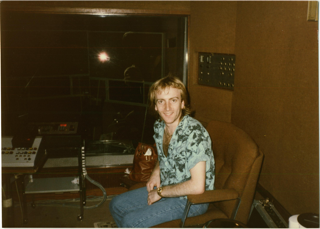 “Phil recording in Paris”
“Phil recording in Paris”
We decided to punch in each chord change separately. Sav would be playing the next chord while the first chord was playing back from the multi track and when the time came we’d just punch in the next chord, eliminating the fret noise completely and giving us a clean smooth jangle sound. Recording like this and trying to get the feel right at the same time could literally take days. We had to double track each part plus add embellishments later on in the song. So we came up with the idea of recording all the parts we needed for the song on a single 8 bar section of music, say the verse. Then we’d do another 8 bars for the bridge. And the same for the chorus. We’d record everything we needed… background vocals, the lot. The idea was to create a whole recorded song on the second multi track machine by offsetting and transferring 8 bars at time from the original multi track machine.
It was revolutionary at the time but something you can do in 5 minutes in Pro Tools now. All we had then though was two Studer A800 analog 24 track tape machines synced together by a synchronizer called the Q lock and an AMS digital delay.
I would offset one machine against the other by 8 bars using time code, which was only frame accurate, so I used an AMS delay in the chain so I could break the increments of the time code down to a smaller amount, milliseconds. Then I would punch in the next 8 bars using the Q lock and AMS to move the timing around until it felt natural as if the band had just played it. So it would take maybe up to 20 tries punching in each time to get the timing right against the click track. If I screwed up a punch l’d have to go back and do the part before again.
It literally had to be perfect, timing wise, for this whole thing to work. Many times I’d walk out of the room, come back in again, and pretend I was hearing the song for the first time (Ha ha) to see if the 8 bar punch-ins were noticeable or not.
It took me a week to do 3 songs this way: Hysteria, Rocket, and Armageddon It. Mutt and the band left me on my own to do this while they were in another room writing more songs. I tell you… sometimes I’d run out of that room screaming. Fortunately we only recorded those three songs that way. The rest of the album we recorded a more conventional way, punching in on the multi track.
You can see now why this album was taking so long to record. Remember that by the time we got to the end of the recording we still had to record Rick’s drums on tape. When we finally got to the mixing stage I was burnt out. It was a relief when Mutt got Mike Shipley in to start the mixing. He came in with fresh ears and was able to create, with Mutt, the drum sound in the mix we needed to sow the album together and make it the classic we know today.
But even still it was not without problems. When we finally got into Mutt’s studio on the first mix there was something seriously wrong with the Fairlight 3. (The Fairlight was one of the first computers you could use to sample sounds, I think it was 16 bit, pretty basic compared to nowadays, but it enabled use to add sounds to the mix you would not be able to do without a sampler in those days. ) Anyhow It just would not stay in time with the multi track tape. I was getting really worried thinking it was something to do with all my hand syncing of tracks earlier on. Fortunately (for me!) we found out the Fairlight at fault and we ended up using another computer sequencer instead. The Synclavier.
The only problem was we didn’t own a Synclavier and there was not many of them in the country, so we had to use one in another studio which meant we had to commit these sounds to the multi-track — something we really didn’t want to do. We wanted the flexibility to have it run live in sync so we could make changes to sounds on the fly. Just like you can in Pro Tools.☺️
The Hysteria album was a testing time for the band and all of us who worked on it. It’s hard to imagine what it feels like to work on an album for three years. Over such a long period even trends in music change. At one point we were trying to soften things up a little, guitar wise. Then suddenly Bon Jovi broke with You Give Love A Bad Name. We thought — shit, now we have to heavy things up again!
There are many more stories about how this album was put together. I know the band will have loads of stories of their own. I’ve mostly talked about the technical side because that was my job and I wanted to explain why we took the approach we did. (And why it took so long!)
But you don’t work with people for three years without getting close to them, personally. I have to say they’re the most down to earth, nicest people you could ever meet. When I came to work with them in Holland they’d just come off a major, highly successful, Pyromania tour in the US. Yet they were the most normal guys you could ever meet. I love it when people in this business don’t change with success… that’s how it should be.
I remember in Holland it was like clocking in every day with Phil to do the daily guitar work. An engineer or producer is expected to be in the studio 100% of the time; not so the band members, usually. But Phil Collen was pretty much with us 100% as well, apart from the mixing. He was a rock on the recording of this album.
And Joe, what can I say? We’d have Foosball tournaments. Joe would look at me like my son, Thomas, does today. “Who the hell are you? You can’t play foosball!” Well, I’m sure Joe will remember things differently but sorry… I have to admit it. I was the Foosball champion. Enough said, okay? I don’t wanna talk about it any more, Joe!. ☺️
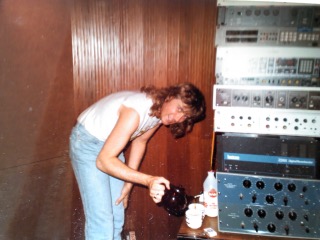 “Joe making the tea for us”
“Joe making the tea for us”
The band are talented guys. They were great to work with, and we became family those 3 years in the studio. It’s hard to wrap your head around the problems they dealt with during the making of Hysteria. I’ve already mentioned Rick’s tragedy but of course we all know that shortly afterwards Steve died. Another utterly devastating blow. How they’ve carried on, I don’t know. We worked tremendously hard and shared laughs and tragedy together.
Finally, like I said, it was a great relief when Mike Shipley got involved. It took the pressure off me and his first few mixes gave us the formula we needed to finish the album. In the end Mike too had to leave after mixing for about 4 months. He and I ended up mixing six songs each.
All I can remember is the last mix took me and Mutt straight through the night into the morning and I had to catch a flight within hours to cut the second side of the album in New York.
Mutt said to me, “Well I guess we’re done, then.”
Yes. Finally!☺️
Lastly, I have to say to you Mike, you saved the day!
Thank you so much, and god bless. Rest in peace, mate.
– Nigel.
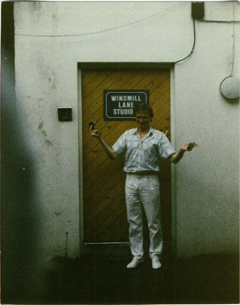 “Myself locking up the studio”
“Myself locking up the studio”
Watch: On The Road with Def Leppard
Go on the road with uDiscover’s Kylie Olsson & the Def Leppard crew!
Watch HERE
Take the Hysteria Buzzfeed Quiz!
Think you know everything about #Hysteria30? Take the BuzzFeed quiz here and find out!
Def Leppard Featured in Daily Express
With over 25 million copies sold worldwide and counting, Hysteria was a difficult album in the making. With the coming and going of guitarists, and a near-fatal car accident, this now multi-platinum album was three years in production.
Now with the re-release of Hysteria being made available, Express caught up with Def Leppard singer Joe Elliott to talk about this period of time…
Read the full story on Daily Express HERE
Watch Joe Elliott’s Live Q&A at Gibson with Planet Rock
Joe Elliott is LIVE celebrating #Hysteria30 at Gibson Studios in London with Planet Rock Radio answering your questions now! Watch the full interview and Q&A below. Continue reading “Watch Joe Elliott’s Live Q&A at Gibson with Planet Rock”
New Billboard.com Interview w/ Band & Hysteria Recording Team
Read now the brand new Billboard interview with the band and recording team on what it took to make Hysteria.
Def Leppard’s ‘Hysteria’ Turns 30: An Oral History of the Album’s Painful Path to Victory
By: Melinda Newman
Hysteria, a meticulously crafted rock masterpiece infused with elements of pop, new wave, glam, and even rap, turned into one of the defining albums of the ’80s, certified 12x platinum by the RIAA and named the No. 25 biggest album ever on the Billboard 200 chart in 2015. The album spawned an extraordinary seven hit singles on the Billboard Hot 100 — including an impressive six top 20-charting smashes. Among those: the top 10s “Hysteria” (No. 10), “Pour Some Sugar On Me” (No. 2), “Love Bites” (their sole No. 1) and “Armageddon It” (No. 3). In the end, Hysteria spent 78 weeks in the top 10 of the Billboard 200 chart — the most weeks spent in the top 10 for an album by a rock band in the chart’s 61-year history.
However, its success was far from certain when it came out Aug. 3, 1987.
In all new interviews, the remaining band members — guitarist Steve Clark died in 1991 — and others involved in the album’s creation and marketing talk about the long road fraught with doubt, pain, joy, drama, misadventures and, ultimately, tremendous triumph. For the first time since Hysteria’s release, recording engineer Nigel Green discusses the groundbreaking, innovative wizardry devised in the studio long before the existence of Pro Tools……
READ THE FULL BILLBOARD ARTICLE HERE

